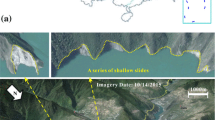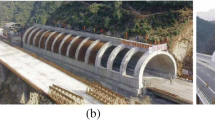Abstract
Engineering experience shows that outward dipping bedded rock slopes, especially including weak interlayers, are prone to slide under rainfall conditions. To investigate the effect of inclined weak interlayers at various levels of depth below the surface on the variation of displacements and stresses in bedded rock slopes, four geo-mechanical model tests with artificial rainfall have been conducted. Displacements, water content as well as earth pressure in the model were monitored by means of various FBG (Fiber Bragg Grating) sensors. The results showed that the amount of displacement of a slope with a weak interlayer is 2.8 to 6.2 times larger than that of a slope without a weak interlayer during one rainfall event. Furthermore, the position of the weak interlayer in terms of depth below the surface has a significant effect on the zone of deformation in the model. In the slope with a high position weak interlayer, the recorded deformation was larger in the superficial layer of the model and smaller in the frontal portion than in the slope with a low position weak interlayer. The slope with two weak interlayers has the largest deformation at all locations of all test slopes. The slope without a weak interlayer was only saturated in its superficial layer, while the displacement decreased with depth. That was different from all slopes with a weak interlayer in which the largest displacement shifted from the superficial layer to the weak interlayer when rainfall persisted. Plastic deformation of the weak interlayer promoted the formation of cracks which caused more water to flow into the slope, thus causing larger deformation in the slope with weak interlayers. In addition, the slide thrust pressure showed a vibration phenomenon 0.5 to 1 hour ahead of an abrupt increase of the deformation, which was interpreted as a predictor for rainfall-induced failure of bedded rock slopes.
Similar content being viewed by others
References
Baum R, Savage W, Godt JW (2008) TRIGRS-A Fortran Program for Transient Rainfall Infiltration and Grid-Based Regional Slope-Stability Analysis, Version 2.0. No. 2008-1159. p 75.
Chae BG, Lee JH, Park HJ, et al. (2014) A method for predicting the factor of safety of an infinite slope basedon the depth ratio of the wetting front induced by rainfall infiltration. Natural Hazards and Earth System Sciences 15: 1835–1849. DOI: 10.5194/nhess-15-1835-2015
Chen H, Lee CF, Law AKT (2004) Causative mechanisms of rainfall-induced fill slope failures. Journal of Geotechnical and Geo-environmental Engineering 130 (6): 593–602. DOI: 10.1061/(ASCE) 1090-0241(2004)130:6(593)
Colin KB, Graeme FS, John OS (2014) Rock-slope failure following Late Pleistocene deglaciation on tectonically stable mountainous terrain. Quaternary Science Reviews 86(1): 144–157. DOI: 10.1016/j.quascirev.2013.12.021
Federici B, Bovolenta R, Passalacqua R (2015) From rainfall to slope instability: an automatic GIS procedure for susceptibility analyses over wide areas. Geomatics Natural Hazards and Risk 7(4): 454–472. DOI: 10.1080/19475705.2013.877087
Fredlund DG, Rahardjo H (1993). Soil mechanics for unsaturated soils. John Wiley and Sons, pp 257–259.
Hoe IL, Wu M, Leshchinsky D (2009) Centrifuge modeling of slopes instability. Journal of Geotechnical and Geoenvironmental Engineering 135(6): 758–767. DOI: 10.1061/(ASCE)GT.1943-5606.0000024
Huang C, Ju YJ, Hwu LK (2009) Internal soil moisture and piezometric responses to rainfall-induced shallow slope failures. Journal of Hydrology 370: 39–51. DOI: 10.1016/j.jhydrol.2009.02.051
Huang C, Yun SC (2010) Experimental investigation of rainfall criteria for shallow slope failures. Geomorphology 120(2): 326–338. DOI: 10.1016/j.geomorph.2010.04.006
Huang F, Zhu H, Xu Q, etc (2013) The effect of weak interlayer on the failure pattern of rock around tunnel-scaled model tests and numerical analysis. Tunnelling and Underground Space Technology 35(1): 207–218. DOI: 10.1016/j.tust.2012.06.014
Egelia I, Pulat HF (2011). Mechanism and modelling of shallow soil slope stability during high intensity and short duration rainfall. Scientia Iranica A 18 (6): 1179–1187. DOI: 10.1016/j.scient.2011.09.010
Kim J, Jeong S, Regueiro R (2012) Instability of partially saturated soil slopes due to alteration of rainfall pattern. Engineering Geology 147: 28–36. DOI: 10.1016/j.enggeo.2012.07.005
Lee ML, Gofar N, Rahardjo H (2009) A simple model for preliminary evaluation of rainfall-induced slope instability. Engineering Geology 108(3): 272–285. DOI: 10.1016/j.nggeo.2009.06.011
Li H, Sun H, Shaeng Y (2009) Influence of rainfall infiltration on slopes by physical model test. Chinese Journal of Geotechnical Engineering 31(4): 589–594. (In Chinese)
Lin H, Yu Y, Li G (2009) Influence of rainfall characteristics on soil slope failure. Chinese Journal of Rock Mechanics and Engineering 28(1): 198–204. (in Chinese)
Liu XY, Zhang XT Xie MW, et al. (2012) GIS-based real-time assessment method of infiltration-stability of rainfall-induced landslide. Chinese Journal of Geotechnical Engineering 34(9): 1627–1635.
Matsuura S, Okamoto T, Asano S (2013) Characteristics of melt-water and/or rainfall regime in a snowy region and its effect on sediment-related disasters. Bulletin of Engineering Geology and the Environment 72(1): 119–129. DOI: 10.1007/s10064-012 -0456-1
Mergili M, Marchesini I, Alvioli M, et al. (2014) A strategy for gis-based 3-d slope stability modelling over large areas. Geoscientific Model Development Discussions 7(4): 5407–5445. DOI: 10.5194/gmd-7-2969-2014
Montrasio L, Valentino R., Losi GL (2009) Rainfall-induced shallow landslides: a model for the triggering mechanism of some case studies in northern Italy. Landslides 6 (3): 241–251. DOI: 10.1007/s10346-009-0154-7
Ng CWW, Shi QA (1998) Numerical investigation of the stability of unsaturated soil slopes subjected to transient seepage. Computers and Geotechnics 22(1): 132–154. DOI: 10.1016/S0266-352X(97)00036-0
Ribolzi O, Patin J, Bresson LM, et al. (2011) Impact of slope gradient on soil surface features and infiltration on steep slopes innorthern Laos. Geomorphology 127(1): 53–63. DOI: 10.1016/j.geomorph.2010.12.004
Raia S, Alvioli M, Rossi M, et al. (2014) Improving predictive power of physically based rainfall-induced shallow landslide models: a probabilistic approach. Geoscientific Model Development 7(2): 495–514. DOI: 10.5194/gmdd-6-1367-2013
Simoni A, Berti M, Generali M (2004) Preliminary result from pore pressure monitoring on an unstable clay slope. Engineering Geology 73: 117–128. DOI: 10.1016/j.enggeo. 2003.12.004
Tohari A, Nishigaki M, Komatsu M (2007) Laboratory rainfall-induced slope failure with moisture content measurement. Journal of Geotechnical and Geo-environmental Engineering 133(5): 575–587. DOI: 10.1061/(ASCE)1090-0241(2007)133: 5(575)
Védie E, Lagarde JL, Font M (2011) Physical modelling of rainfall-and snowmelt-induced erosion of stony slope underlain by permafrost. Earth Surface Processes and Landforms 36(3): 395–407. DOI: 10.1002/esp.2054
Wang DD, Li L, Li ZY. (2014) A regularized Lagrangian meshfree method for rainfall infltrationtriggered slope failure analysis. Engineering Analysis with Boundary Elements 42: 51–59. DOI: 10.1016/j.enganabound.2013.09.001
Wang H, Gao JE, Zhang MJ (2015) Effects of rainfall intensity on groundwater recharge based on simulated rainfall experiments and a groundwater flow model. Catena 127(1): 80–91. DOI: 10.1016/j.catena.2014.12.014
Wang R, Zhang G, Zhang JM (2010) Centrifuge modelling of clay slope with montmorillonite weak layer under rainfall conditions. Applied Clay Science 50(3): 386–394. DOI: 10.1016/j.clay.2010.09.002
Zhang G, Wang R, Qian JY (2012) Effect study of cracks on behavior of soil slope under rainfall conditions. Soils and Foundations 52(4): 634–643. DOI: 0.1016/j.sandf.2012.07.005
Author information
Authors and Affiliations
Corresponding authors
Additional information
http://orcid.org/0000-0003-0784-3791
http://orcid.org/0000-0002-3159-1689
Rights and permissions
About this article
Cite this article
Li, Lq., Ju, Np. Effect of the inclined weak interlayers on the rainfall response of a bedded rock slope. J. Mt. Sci. 13, 1663–1674 (2016). https://doi.org/10.1007/s11629-015-3594-7
Received:
Revised:
Accepted:
Published:
Issue Date:
DOI: https://doi.org/10.1007/s11629-015-3594-7




